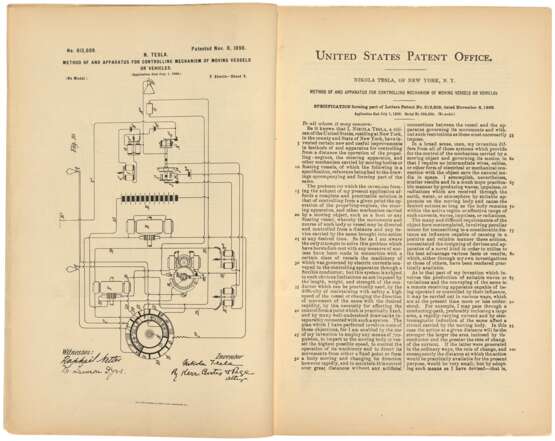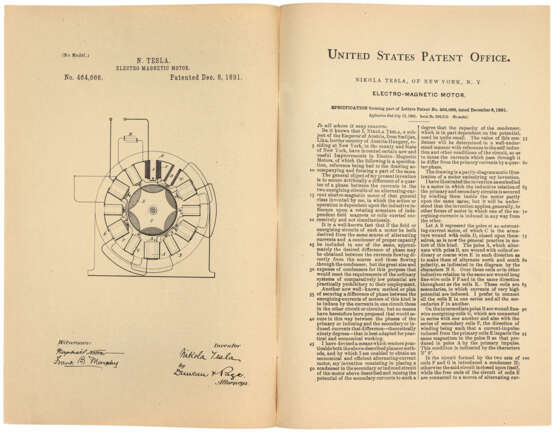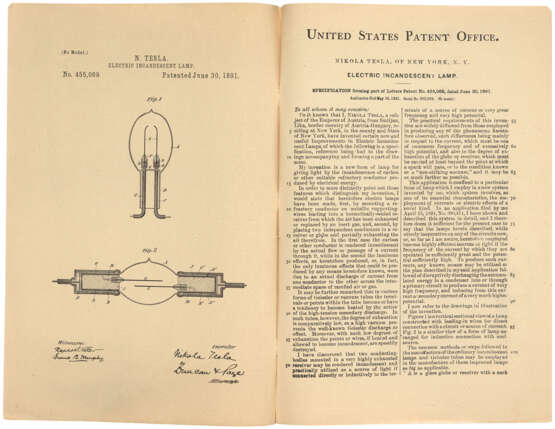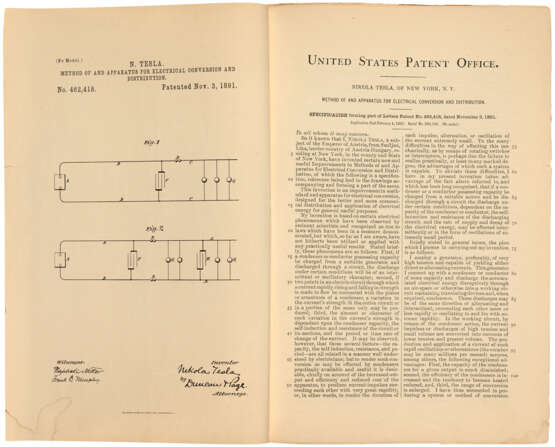ID 369991
Lot 2 | Tesla patents : an archive of inventive genius
Valeur estimée
£ 120 000 – 160 000
Collection of 50 original patents. Washington DC: Norris-Peters Co. for the USPTO, 1886-1914. In a modern black morocco-backed cloth clamshell box.
Fifty separate patents, each of 3-7 pages with at least one drawing with schematics. The vast majority has an annotated note in a contemporary hand on the front blank leaf indicating the patent holder (Tesla), the patent number, and often the date the application was filed, date of issuance and date of expiration. Some have underlining in the text.
An extraordinary collection of Tesla’s patents, including those for the invention of radio (disputed by Marconi), the ‘Tesla coil’ and power transmissions systems, remote-controlled devices, AC motors, generators, incandescent and arc-lighting, transformers, and many others.
Printed and issued by the US Patent and Trademark Office (USPTO), at least two copies of a patent would be sent to the applicant, or (more usually) their attorneys. Since the vast majority of the patents in this lot are bound using three staples (the standard USPTO format), all have annotations on the upper cover (i.e. first blank recto self-wrapper), lacking any additional printing on the documents, and with some of them bearing the name of the USPTO printer, the Norris-Peters Company of Washington DC, it is highly probable that these patents are those sent by the USPTO directly to Tesla’s attorneys.
All of these patents are of extreme rarity. We have been unable to locate any other copies, other than the original ‘Letters patent’ issued by the USPTO and now held at the US National Archives. None are listed on Worldcat, and only one Tesla patent (a minor one relating to his system of AC power transmission) has ever appeared at auction (Bonhams New York, 15 October 2008, lot 1204; ABPC/RBH)
‘He was an inventor, an engineer, a scientist and an oddball … more than any one man, Nikola Tesla is responsible for the twentieth century’ (Hunt, introduction to Nikola Tesla: My Inventions and Other Writings, 2011).
‘Were we to seize and eliminate from our industrial world the result of Mr. Tesla’s work, the wheels of industry would cease to turn, our electric cars and trains would stop, our towns would be dark and our mills would be idle and dead. His name marks an epoch in the advance of electrical science’ (B.A. Behrend, Vice President of the American Institute of Electrical Engineers, in his speech presenting Tesla with the Edison medal in 1917).
Biography:
Nikola Tesla was born in Smiljan, Lika [now Croatia] in 1856 as the fourth child of Milutin and Djuka Tesla. He often attributed his mother’s influence to setting himself on the path of becoming an inventor. Tesla’s technical education was limited to two years polytechnic studies at Gratz, Styria [now Austria]. From Gratz he went to Prague with the object of completing his education, and thence to Budapest where he obtained work in a new telephone company. It was there that in 1882 that Tesla invented his induction motor and an alternating-current (AC) system of power transmission. He moved to Paris seeking better opportunities to market his invention, and worked for two years as an electrical engineer. In 1884, Tesla accepted a position at the Edison Company in New York, where he designed DC dynamos and motors. However, Edison was not interested in Tesla’s alternating currents system, and Tesla soon departed.
He established the Tesla Electric Light and Manufacturing Company in conjunction with the businessmen Benjamin A. Vail and Robert Lane, and soon installed arc-lamp street lighting in Vail’s home town of Rahway, New Jersey. ‘It was not until he formed the new Tesla Electric Company [that Tesla was able] to realize his inventions and develop working models of motors, generators and transformers … Many of these inventions were later “reinvented” by others without referring to Tesla’ (Sarkar, p. 269).
Following this successful period, Tesla was eased out of the company by Vail and Lane, and entered one of the most depressing periods of his life. However, by 1887, Tesla had met A.K. Brown, manager of the Western Union Telegraph Company, and with his backing formed a new company, The Tesla Electric Company, with the goal of developing AC systems. Situated only a few blocks away from Edison’s premises, Tesla and Edison engaged in the ‘war of the currents’ (see no 5, patent 464,666). ‘In 1890-1891, … having successfully delivered his polyphase induction system, he would seek the means to deliver power wirelessly. Second, he would try to invent new methods of illumination. And third, he would investigate the wireless transmission of intelligence. These broad goals established the direction of work that would occupy Tesla for the next 50 years’ (Sutherland-Cohen, p.64).
On March 13, 1895 Tesla’s New York laboratory burned down, and he had to move to new premises on Houston Street. This stopped his research in the field of high frequency currents for some time. ‘After the lectures in 1893 in which he had described in detail the six basic requirements of radio transmission and reception, he had built equipment that could be operated between his laboratory and various points with New York City. The fire had destroyed all this and had set back his research, but by the spring of 1897 … he was prepared to move ahead’ (Cheney, p. 109). This setback allowed Marconi to steal a march on Tesla in the field of radio transmission (see nos 38, patent 645,576, and 39, patent 649,621)..
From the 1890s through 1906, Tesla spent much of his time and fortune on a series of projects trying to develop the transmission of electrical power without wires. It was an expansion of his idea of using his Tesla coil to transmit power that he had been demonstrating in wireless lighting. He saw this as a way to transmit large amounts of power around the world. By the mid-1890s, Tesla was working on the idea that he might be able to conduct electricity long distances through the Earth or the atmosphere, and began working on experiments to test this idea including setting up a large resonance transformer magnifying transmitter in his Houston Street lab. He proposed a system of balloons suspending, transmitting, and receiving, electrodes in the air above 30,000 feet in altitude, where he thought the lower pressure would allow him to send high voltages (millions of volts) long distances. To further study the conductive nature of low-pressure air, Tesla set up an experimental station at high altitude in Colorado Springs during 1899. To fund his experiments, he convinced John Jacob Astor IV to invest $100,000. Astor thought he was primarily investing in the new wireless lighting system, but Tesla used the money to fund his Colorado Springs experiments. Patents 42-47 refer to results obtained in these experiments.
‘However, doubts arose among his investors about the plausibility of Tesla’s system. As his rival, Guglielmo Marconi – with the financial support of Andrew Carnegie and Thomas Edison – continued to make great advances with his own radio technologies, Tesla had no choice but to abandon the project … Two years later Tesla declared bankruptcy … Poor and reclusive, Nikola Tesla died on January 7, 1943, at the age of 86, in New York City, where he had lived for nearly 60 years’ (Hunt).
Contents:
A list of the patents follows; the first date is when the patent was filed; the second is when it was granted. In 1980, John T. Ratzlaff published Dr. Nikola Tesla. Selected Patent Wrappers from the National Archives. He wrote: ‘Twenty of the Tesla patent wrappers have been selected for this publication on the basis of importance and current interest.’ Of these 20 patents, 16 are in the present collection, and are marked *. For a description of condition, please see the separate condition report.
1. 334,823. Commutator for Dynamo-Electric Machines. May 6, 1885; January 26, 1886. 2 pp.
2. 335,786. Electric-Arc Lamp. July 13, 1885; February 9, 1886. 5 pp.
These two patents, 334,823 and 335,786, were the first to be applied for by, and granted to, Tesla. The former was the first to be granted but the latter was the first to be submitted. They were the result of Tesla’s development of the electric arc lamp, and he eventually installed such lamps as street lighting in Rahway, New Jersey.
3. 455,069. Electric Incandescent Lamp. May 14, 1891; June 30, 1891. 3 pp.
4. 462,418. Method of and Apparatus for Electrical Conversion and Distribution. February 4, 1891; November 3, 1891. 4 pp.
The patent for the invention that would ultimately become known as the Tesla coil. One of Tesla’s greatest inventions, the Tesla coil would be used in various forms for future radio and television applications. In several spectacular public lectures in 1893, Tesla showed how the Tesla coil could be used to produce a wireless lighting system, lighting Geissler tubes and even incandescent light bulbs from across a stage with no intervening wires. These demonstrations did not lead to commercial products, but they made Tesla famous.
The collection also contains the following patents giving further developments and refinements of the same device: 6, 12, 13, 14, 19-24, 26-32, 34-36, 40-46, and 48-50.
5. 464,666. Electro-Magnetic Motor. July 13, 1891; December 8, 1891. 3 pp.
In the spring of 1887 Telsa met A.K. Brown, manager of the Western Union Telegraph Company. Brown was interested in Tesla’s ideas about AC power transmission, and they formed a new company, the Tesla Electric Company, with the goal of developing the AC system. It was based only a few blocks from Edison’s workshops in New York City. Thus began the ‘war of the currents,’ between Edison’s DC system and Tesla’s AC system of power transmission. This patent, 464,666, refers to this ‘war’, and was the very last patent granted to Tesla for his ‘polyphase’ AC system.
6. 464,667. Electrical Condenser. August 1, 1891; December 8, 1891. 2 pp.
7. 487,796. System of Electrical Transmission of Power. May 15, 1888; December 13, 1892. 6 pp.
8. 511,559. Electrical Transmissions of Power. December 8, 1888; December 26, 1893. 3 pp.
9. 511,560. System of Electrical Power Transmission. December 8, 1888; December 26, 1893. 6 pp.
10. 511,915. Electrical Transmission of Power. May 15, 1888; January 2, 1894. 3 pp.
11*. 511,916. Electric Generator. August 19, 1893; January 2, 1894. 6 pp.
12*. 512,340. Coil for Electro-Magnets. July 7, 1893; January 9, 1894. 3 pp.
13. 514,167. Electrical Conductor. January 2, 1892; February 6, 1894. 3 pp.
14. 514,168. Means for Generating Electric Currents. August 2, 1893; February 6, 1894. 3 pp.
15*. 514,169. Reciprocating Engine. August 19, 1893; February 6, 1894. 4 pp.
16. 514,170. Incandescent Electric Light. January 2, 1892; February 6, 1894. 3 pp.
17. 514,972. Electric-Railway System. January 2, 1892; February 20, 1894. 3 pp.
Tesla’s experiments with his Tesla coil convinced him that it should be possible to transmit electric power wirelessly. This patent was a serious proposal to use wireless transmission to power electric trains. A major flaw in the electric streetcars that were a common sight in Tesla’s day was the rolling or sliding contact that transferred electricity from the overhead lines to the car. In this patent for an Electric Railway System, Tesla proposes a form of underground wireless power transmission. The power is conducted down a buried channel in which the streetcar’s J-shaped lead passes to pick up and transfer the energy to the car.
18. 514,973. Electrical Meter. December 15, 1893; February 20, 1894. 3 pp.
19*. 568,176. Apparatus for Producing Electric Currents of High Frequency and Potential. April 22, 1896; September 22, 1896. 4 pp.
20. 568,177. Apparatus for Producing Ozone. June 17, 1896; September 22, 1896. 4 pp.
21. 568,178. Method of Regulating Apparatus for Producing Currents of High Frequency. June 20, 1896; September 22, 1896. 5 pp.
22. 568,179. Method of and Apparatus for Producing Currents of High Frequency. July 6, 1896; September 22, 1896. 4 pp.
23*. 568,180. Apparatus for Producing Electrical Currents of High Frequency. July 9, 1896; September 22, 1896. 4 pp.
24. 577,670. Apparatus for Producing Electrical Currents of High Frequency. September 3, 1896; February 23, 1897. 4 pp.
25. 577,671. Manufacture of Electrical Condensers, Coils, . November 5, 1896; February 23, 1897. 3 pp.
26. 583,953. Apparatus for Producing Currents of High Frequency. October 19, 1896; June 8, 1897. 3 pp.
27. 593,138. Electrical Transformer. March 20, 1897; November 2, 1897. 4 pp.
28. 609,245. Electrical-Circuit Controller. December 2, 1897; August 16, 1898. 5 pp.
29. 609,246. Electric-Circuit Controller. February 28, 1898; August 16, 1898. 4 pp.
30. 609,247. Electric-Circuit Controller. March 12, 1898; August 16, 1898. 3 pp.
31. 609,248. Electric-Circuit Controller. March 12, 1898; August 16, 1898. 3 pp.
32. 609,249. Electrical-Circuit Controller. March 12, 1898; August 16, 1898. 3 pp.
33. 609,250. Electrical Igniter for Gas-Engines. June 15, 1898; August 16, 1898. 3 pp.
34. 609,251. Electrical-Circuit Controller. June 15, 1898; August 16, 1898. 5 pp.
35. 611,719. Electrical-Circuit Controller. December 10, 1897; October 4, 1898. 5 pp.
36. 613,735. Electric-Circuit Controller. April 19, 1898; November 8, 1898. 5 pp.
37*. 613,809. Method of and Apparatus for Controlling Mechanism of Moving Vessels or Vehicles. July 1, 1898; November 8, 1898. 13 pp.
This patent describes one of Tesla’s inventions that was almost a century ahead of his time – robotics. ‘In 1898, he developed the first radio-controlled boat, the ancestor of today’s remote-controlled drones … Tesla soon realized that if he could power devices such as lamps at a distance, he could also turn them on and off and thus control them. But rather than just control lamps, why not create an automaton, or what we might call a robot? To test out this idea, Tesla began building a prototype and chose to design a boat in response to the naval armaments race then underway” (https://www.forbes.com/sites/berniecarlson/2018/07/11/nikola-teslas-third-greatest-invention-the-first-drone/#304c3da864d6)
‘The inventor did not disclose more than his fundamental idea in his basic patent No. 613,809 (37) – a means he had learned to use to protect his discoveries … The remarkable stage of development to which he had carried wireless, the forerunner of modern radio, would have been quite enough; but to introduce automation simultaneously, as he did, was probably too great a leap. On that day in 1898 when he demonstrated the common ancestor of modern guided weapons and vehicles, of automated industry, and of robotics, he was introducing an idea for which the world would not be ready for many years’ (Cheney, p. 124).
38*. 645,576. System of Transmission of Electrical Energy. September 2, 1897; March 20, 1900. 7 pp.
39*. 649,621. Apparatus for Transmission of Electrical Energy. September 2, 1897; March 15, 1900. 4 pp.
‘On September 2, 1897 Tesla filed the patent application No. 650,343, subsequently granted as patent No. 645,576 (38) of March 20, 1900 and patent No. 649,621 (39) of May 15, 1900. The two patents by which Tesla protected his system and apparatus for wireless transmission are known as ‘system of four tuned circuits’. This fact is particularly important in the history of radio. They were the subject of a long lawsuit brought by the Marconi Wireless Telegraph Company of America against the United States of America, alleging that they have used wireless devices that infringed on Marconi patent No. 763,772 of June 28, 1904 [which was filed on November 10, 1900, a few months after Tesla’s had been granted] … the United States Supreme Court on June 21, 1943 invalidated the fundamental American radio patent of Marconi No. 763,772 … The Supreme Court cited Tesla’s system in its deliberations:
“The Tesla patent No. 645,576, applied for September 2, I897 and allowed March 20, 1900, disclosed a four circuit system, having two circuits each at transmitter and receiver, and recommended that all four circuits be tuned to the same frequency. Tesla’s apparatus was devised primarily for transmission of energy of any form of energy-consuming device by using the rarefied atmosphere at high elevations as a conductor when subjected to the electrical pressure of a very high voltage. But he also recognized that his apparatus could, without change, be used for wireless communication, which is dependent upon the transmission of electrical energy. His specifications declare: ‘The apparatus which I have shown will obviously have many other valuable uses – as, for instance, when it is desired to transmit intelligible messages to great distances …”’ (Sarkar, pp. 274-275).
Tesla was the first to patent the technology of radio communication, but it was Marconi who successfully commercialized it and was rewarded with the Nobel Prize in Physics 1909, shared with Karl Ferdinand Braun ‘in recognition of their contributions to the development of wireless telegraphy.’
40. 11,865. Method of Insulating Electric Conductors. August 14, 1900; October 23, 1900. 6 pp.
41*. 685,012. Means for Increasing the Intensity of Electrical Oscillations. March 21, 1900; October 22, 1901. 4 pp.
Patents 11,865 (40) and 685,012 (41) show Tesla to have anticipated the field of cryogenics. ‘The first patent he filed on his return [to New York City from Colorado Springs] (No. 685,012) was a means for increasing the intensity of electrical oscillations, the medium for doing so being liquefied air to cool the coil and thus reduce its electrical resistance. He also received two other patents in 1900 and 1901 related to buried power transmission lines and the method of insulating them by freezing a surrounding dielectric medium such as water. One, a reissued patent (No. 11,865), referred to a ‘gaseous’ cooling agent – apparently a key word that had been inadvertently omitted from his original patent No. 655,838. He was therefore one of the originators of cryogenic engineering.
“Many years later, in the 1970s, developmental projects were initiated in America, Russia, and Europe for methods of using superconductors to transmit underground bulk electrical power, employing various cryogenic enclosures … The similarity moves closer, however, when considering Tesla’s patent No. 685,012, in which he describes the supercooling of conductors to appreciably lower their resistance, thereby minimizing their dissipation when conducting current. This is yet another instance in which his pioneer work had gone unacknowledged” (Cheney, pp. 152-153).
42*. 685,953. Method of Intensifying and Utilizing Effects Transmitted through Natural Media. June 24, 1899; November 5, 1901. 6 pp.
43*. 685,954. Method of Utilizing Effects Transmitted through Natural Media. August 1, 1899; November 5, 1901. 9 pp.
44*. 685,955. Apparatus for Utilizing Effects Transmitted from a Distance to a Receiving Device through Natural Media. June 24, 1899; November 5, 1901. 7 pp.
45*. 685,956. Apparatus for Utilizing Effects Transmitted through Natural Media. August 1, 1899; November 5, 1901. 8 pp.
46. 685,957. Apparatus for the Utilization of Radiant Energy. March 21, 1901; November 5, 1901. 5 pp.
47. 685,958. Method of Utilizing Radiant Energy. March 21, 1901; November 5, 1901. 1 full-page photolithographic diagram with 2 figs,3 pp. text.
Nos 46 and 47 describe a precursor to modern solar cell technology and other photoelectric devices.
48*. 723,188. Method of Signaling. July 16, 1900; March 17, 1903. 1 full-page photolithographic diagram with 5 figs, 4 pp. text.
This patent demonstrates that Tesla foresaw modern logical computer circuitry. ‘Inventors of modern computer technology in the last half of the twentieth century repeatedly have been surprised, when seeking patents, to encounter Tesla’s basic ones, already on file … Tesla’s patents 723,188 and 725,605 [this latter not present in this collection] contain the basic principles of the logical AND circuit element … Thus … early Tesla patents … have proved to be an obstacle for anyone attempting to obtain a basic logical AND circuit element patent in this era of modern computer technology’ (Cheney, pp. 130-131).
49*. 787,412. Art of Transmitting Electrical Energy through the Natural Mediums. May 16, 1900; April 18, 1905. 1 full-page photolithographic diagram with 2 figs, 5 pp. text.
50*. 1,119,732. Apparatus for Transmitting Electrical Energy. January 18, 1902; December 1, 1914. 1 full-page photolithographic diagram, 3 pp. text.
‘Around 1900, Tesla set to work on his boldest project yet: to build a wireless global communication system – to be transmitted through a large electrical tower – for sharing information and providing free electricity throughout the world. With funding from a group of investors that included financial giant J.P. Morgan, in 1901 Tesla began work on the project in earnest, designing and building a lab with a power plant and a massive transmission tower on Long Island, New York, that became known as Wardenclyffe (Hunt). Nos 49 and 50 are important patents referring to the Wardenclyffe experiments: patent 787,412 (49) describes Tesla’s proposed mechanism of transmitting electrical signals through the Earth, while 1,119,73249 (50), filed in 1902 but not issued until 1914, gives a detailed description and illustration of the Wardenclyffe tower itself.
Further reading:
Anderson, Priority in invention of radio, Tesla v. Marconi, Antique Wireless Association, March, 1980, Monograph New Series No. 4.
Carlson, Tesla. Inventor of the Electrical Age, 2013
Cheney, Tesla. Man Out of Time, 2001
Sarkar et al, History of Wireless, 2006
Sutherland-Cohen, Tesla for Beginners, 2016.
| Adresse de l'enchère |
CHRISTIE'S 8 King Street, St. James's SW1Y 6QT London Royaume-Uni | |
|---|---|---|
| Aperçu |
| |
| Téléphone | +44 (0)20 7839 9060 | |
| Commission | see on Website | |
| Conditions d'utilisation | Conditions d'utilisation |








